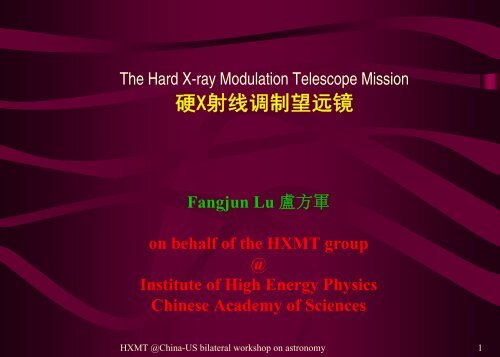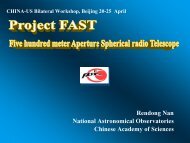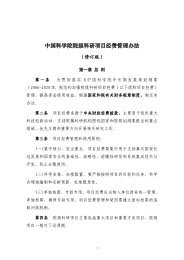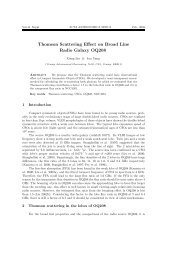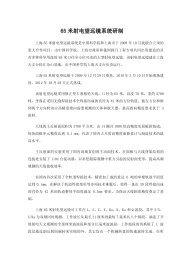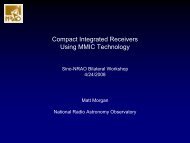The Hard X-ray Modulation Telescope Mission
The Hard X-ray Modulation Telescope Mission
The Hard X-ray Modulation Telescope Mission
- No tags were found...
You also want an ePaper? Increase the reach of your titles
YUMPU automatically turns print PDFs into web optimized ePapers that Google loves.
<strong>The</strong> <strong>Hard</strong> X-<strong>ray</strong> <strong>Modulation</strong> <strong>Telescope</strong> <strong>Mission</strong>硬 X 射 线 调 制 望 远 镜Fangjun Lu 盧 方 軍on behalf of the HXMT group@Institute of High Energy PhysicsChinese Academy of SciencesHXMT @China-US bilateral workshop on astronomy 1
<strong>The</strong> <strong>Hard</strong> X-<strong>ray</strong> <strong>Modulation</strong> <strong>Telescope</strong> (HXMT)Chinese Academy of SciencesTsinghua UniversityChinese Academy of Space TechnologyHXMT @China-US bilateral workshop on astronomy 2
Payload CabinPlatform CabinHXMT @China-US bilateral workshop on astronomy 3
ME:Si-PIN,952 cm 2HE: NaI/CsI 5000 cm 2LE:SCD,384 cm 2Payloads onboard HXMTSize:1900×1600×1000 mmHXMT @China-US bilateral workshop on astronomy 4
Characteristics of the HXMT <strong>Mission</strong>• Main Detector NaI(Tl)/CsI(Na) Phoswich– Total Detect Area ~5000 cm 2– Energy Range 20~250 keV– Energy Resolution ~19% (@60keV)– Continuum Sensitivity ~3.0×10 -7 ph cm -2 s -1 keV -1 ,or 0.5 mCrab (3σ@100keV,10 5 s)– Field of View 5.7°x 5.7°(FWHM)– Source Location ≤1 arcmin(20σ)– Angular Resolution ≤5 arcmin(20σ)• Secondary Instruments ME (5-30 keV, Si-PIN, 952 cm 2 ),LE (1-15 keV, SCD, 384 cm 2 )• Mass 2700 kg (payload ~1000 kg)• Dimension 2.0×2.0×2.8 m 3 (L×W×H)• Nominal <strong>Mission</strong> lifetime 4 years• Orbit Altitude 550km,Inclination 43°• Attitude Three-axis stabilizedControl precision:±0.10°Stability: 0.005 °/sMeasurement accuracy:
<strong>The</strong> Configuration of the main detector assemblyActive ShieldCollimatorPhoswichdetectorStructuresPMTHXMT @China-US bilateral workshop on astronomy 7
Shielding RingCollimatorDetectorEach module has a field of view(FOV) of 5.7º×1.1º and the longaxes of two neighboring FOVsdiffer by 10º.HXMT @China-US bilateral workshop on astronomy 8
<strong>The</strong> Main Detector system of the HXMTHXMT @China-US bilateral workshop on astronomy 9
<strong>The</strong> medium energy <strong>Telescope</strong> (ME)Objectives: 5-30 keV sky survey and pointedobservationsDetector:Energy coverage:Detecting area:Sensitivity:Field of view: 1°×6°Energy resolution: < 3 keVTime resolution: 10 μsMass:60kgSi-PIN5-30 keV952 cm 2 (1944 pixels)0.25 mCrab2008-4-29HXMT @China-US bilateralworkshop on astronomy 10
MEUnit1 Unit 2 Unit 3 Unit 4 Unit 5 Unit 6Modu 1Modu 2 …… Modu 9Pixel 1 Pixel 2 …… Pixel 362008-4-29Architecture of HXMT/MEHXMT @China-US bilateralworkshop on astronomy 11
<strong>The</strong> low energy <strong>Telescope</strong> (LE)Objectives: low energy (1-15 keV) sky surveyand pointed observationsDetector:Energy coverage:Detecting area:Sensitivity:Field of view: 1°×6°& 1°×3°Energy resolution: < 450 keVTime resolution: 1 msMass:60 kgSCD (Swept Charge Device)1-15 keV,384 cm 2 (96 CCD236 chips)0.15 mCrab2008-4-29HXMT @China-US bilateralworkshop on astronomy 13
2×2CCD23616 cm 2HXMT @China-US bilateral workshop on astronomy 14
Charge flowReal & dummyoutputs in gapSCD read the events through the diagonal line. It reacheshigh time resolution (1ms) by sacrificing the positioninformation.HXMT @China-US bilateral workshop on astronomy 15
CCD236 55 Fe spectrum@-30.7°CE(keV)=0.00641*Ch-2.761FWHM=128eV@5.9keV; rms=6.9e -HXMT @China-US bilateral workshop on astronomy 16
Advantages of LE for X-<strong>ray</strong> timing/spectroscopyDetectorArea(cm 2 @ 6keV)Time resolution Energy resolution(@ 6 keV)EXOSAT/ME 1600 ~ms 1200 eVNoteGinga/LAC 4000 ~msASCA/GIS 250 0.06 msRXTE/PCA 5000 1μs1200 eV460 eV1125 eVChandra/ACIS200 3 ms 130 eV High pileup effect(CC mode)Chandra/HRC 40 16μsbadfor strong sourceXMM/MOS 768 1.5 ms 130 eV High pileup effect forstrong sourceHXMT/LE 240 1 ms 130 eV No pileup for 10Crab sourceHXMT @China-US bilateral workshop on astronomy 17
<strong>The</strong> imaging performance of the HXMT/HE20 sigma sourceSource Location
Simulated in-space background of HXMT/HEHXMT @China-US bilateral workshop on astronomy 19
Contributions of various components to the total backgroundHXMT @China-US bilateral workshop on astronomy 20
SensitivityHXMT/HEHXMT @China-US bilateral workshop on astronomy 21
Integral/IBIS HXMT/HE Swift/BATAngular Resolution 12’ < 5’ 14’Source Location (20σ) 1’ < 1’ 1’Pointed Sensitivity (mCrab@100 keV) 3.8 0.5 9Half Year Survey Sensitivity (mCrab) 2 0.5 1Observation CapabilityAll sky survey okgood yesSelected sky deep survey good good badNarrow field pointing observation badgood noHXMT @China-US bilateral workshop on astronomy 22
Observation modes• All-sky Survey mode• Deep imaging observation of selected skyregions• Pointed observationsHXMT @China-US bilateral workshop on astronomy 23
HXMT in all-sky surveyHXMT @China-US bilateral workshop on astronomy 24
HXMT Sky Survey ObservationsExposuredistribution ofthe one year’sall-sky surveyHXMT @China-US bilateral workshop on astronomy 25
Cosmic X-<strong>ray</strong> Background and the resolvedfraction as a function of energyWe can see:1)<strong>The</strong> hard X-<strong>ray</strong> background was studied only by HEAO-1 A42) <strong>The</strong> hard X-<strong>ray</strong> background has not been well resolved.3)<strong>The</strong> CXB peaks around 20-30 keV.4)A more sensitive all-sky hard X-<strong>ray</strong> survey is demanding.HXMT @China-US bilateral workshop on astronomy 26
Simulation of a 0.5mCrab source in halfyear’s all-sky surveyLeft: Distribution of the background fluctuation; Right: Distribution of the source significance<strong>The</strong> highest background fluctuation is 3.15σ, and in 60% of thesimulations the source has a significance higher than 3.15 σ. Soa half-year all-sky survey can reach a sensitivity of 0.5 mCrab.HXMT @China-US bilateral workshop on astronomy 27
One-year sky survey sensitivity distribution (mCrab)HXMT @China-US bilateral workshop on astronomy 28
AGN Luminosity function0.42mCrab0.5mCrabAbout 1000 AGNs will be discovered in the HXMT all-sky surveyHXMT @China-US bilateral workshop on astronomy 29
<strong>The</strong> main objective of HXMT sky survey is todetect about 1000 AGNs in the hard X-<strong>ray</strong> band 。≥2010 <strong>Hard</strong> X-<strong>ray</strong> SkyHXMTHXMT @China-US bilateral workshop on astronomy 30
Simulated HXMT AGN luminosity functionINTEGRAL AGNluminosity functionHXMT @China-US bilateral workshop on astronomy 31
Pointed observationsHXMT @China-US bilateral workshop on astronomy 32
Scientific objectives of the pointed observations• X-<strong>ray</strong> Binary: multi-wavelength X-<strong>ray</strong> variability;especially the QPO properties of BH binaries atenergy higher than 20 keV;• Cyclotron Resonance Features (CRF) close tothe neutron star surface;• Broad band (1-250 keV) AGN spectrum,reflecting components and high energy cut off;• <strong>Hard</strong> X-<strong>ray</strong> emission from clusters of galaxies;• Non-thermal X-<strong>ray</strong> emission of SNRs andcosmic-<strong>ray</strong> acceleration。HXMT @China-US bilateral workshop on astronomy 33
Previous hard X-<strong>ray</strong> telescopes are of too small collectingarea (
Cyclotron Resonance Features in neutron star binariesTruemper et al. 1978, ApJ 215, L109HXMT @China-US bilateral workshop on astronomy 35
Simulated HXMT/HE spectrum of Her X-1Left: <strong>The</strong> absorption line is as strong as in Truemper et al.(1978). Right: If the absorption feature is 10 times weaker, itcan also be detected at 10σ confidence level.HXMT @China-US bilateral workshop on astronomy 36
Broad band X-<strong>ray</strong> spectrum of AGN(Pounds et al. 2003, MNRAS, 341, 953)X-<strong>ray</strong> spectrum of MCG 6-30-15 by SuzakuOne of HXMT’sscientific objectives isjust to measure thebroad band X-<strong>ray</strong> Xspectrum of AGNs.HXMT @China-US bilateral workshop on astronomy 37
Simulated HXMT spectrum of AGN<strong>The</strong> reflecting component notincluded in the model<strong>The</strong> reflecting componentincluded in the modelHXMT @China-US bilateral workshop on astronomy 38
<strong>Hard</strong> X-<strong>ray</strong> from clusters of galaxiesFusco-Femiano et al. , 1999, ApJ 513, L21;Evidence for hard X-<strong>ray</strong> emission in the Coma clusterHXMT @China-US bilateral workshop on astronomy 39
Debate on the hard X-<strong>ray</strong> emission of the Comacluster1. <strong>Hard</strong> X-Ray Radiation in the Coma Cluster Spectrum,Fusco-Femiano et al. , 1999, ApJ 513, L21;2. Is there a hard tail in the Coma Cluster X-<strong>ray</strong> spectrum?,Rossetti & Molendi, 2004, A&A 414, L41;3. Confirmation of Nonthermal <strong>Hard</strong> X-Ray Excess in the ComaCluster from Two Epoch Observations, Fusco-Femiano et al.,2004, ApJ 602, L73;4. Nonthermal <strong>Hard</strong> X-Ray Excess in the Coma Cluster:Resolving the Discrepancy between the Results of DifferentPDS Data Analyses, Fusco-Femiano et al., 2007, ApJ 654, L9;5. <strong>The</strong> Coma Cluster hard X-<strong>ray</strong> spectrum revisited: still noevidence for a hard tail, Rossetti & Molendi, 2007, astroph/0702417;6. <strong>Hard</strong> X-Ray Excess in the Coma Cluster: a Reply to Rossetti &Molendi (astro-ph/0702417) , Fusco-Femiano et al. 2007, astroph/0702576.HXMT @China-US bilateral workshop on astronomy 40
Simulated hard X-<strong>ray</strong> spectrum of Coma byHXMT/HEHXMT will make sure whether there is hard X-<strong>ray</strong> emissionin the coma cluster and further quantify its hard X-<strong>ray</strong> flux.HXMT @China-US bilateral workshop on astronomy 41
Main advantages and key sciences of HXMT<strong>Hard</strong> X-<strong>ray</strong> sky survey with highest sensitivity• High precision hard X-<strong>ray</strong> full sky map: diffuse background and cosmic variance• Discover highly obscured supermassive BHs: galaxy formation and evolution• Discover new types of high energy objects: usual surprises of new surveysHigh precision pointed observations of high energy objects• Space-time in strong gravitational field: dynamics and radiation near BHhorizons of stellar mass and supermassive BHs• Equation of state in strong magnetic field: neutron star and its surface properties• High energy particle acceleration: AGN, SNR, shock and relativistic jets• Large scale structure: through hard X-<strong>ray</strong> detection of galaxy clustersHXMT @China-US bilateral workshop on astronomy 42
Schedule of HXMT• Satellite Ready: end of 2010• Year I: All-sky survey (No AO time)• Year II: Pointed Observations and small region imaging.( 3 months for AO)• Year III: Pointed Observations (6 months for AO)• Year IV: Pointed Observations and imaging ( 3 months for AO)• >Year V: (7 months for AO per year)HXMT @China-US bilateral workshop on astronomy 43
Thanks!HXMT @China-US bilateral workshop on astronomy 45


